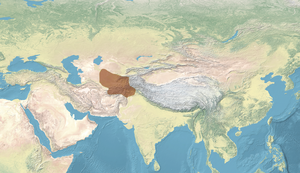Kidarites | |||||||||||||
|---|---|---|---|---|---|---|---|---|---|---|---|---|---|
| 320 CE–467 CE | |||||||||||||
Tamga of the Kidarites
| |||||||||||||
Territory of the Kidarite kingdom, and main Asian polities c. 400 | |||||||||||||
Territory of the Kidarites, c. 400 | |||||||||||||
| Capital | Bactria | ||||||||||||
| Common languages | Bactrian (written) | ||||||||||||
| Religion | Buddhism Hinduism | ||||||||||||
| Government | Monarchy | ||||||||||||
| Kushanshah | |||||||||||||
• fl. 320 | Kidara | ||||||||||||
• fl. 425 | Varhran I | ||||||||||||
• fl. 500 | Kandik | ||||||||||||
| Historical era | Late Antiquity | ||||||||||||
• Established | 320 CE | ||||||||||||
• Disestablished | 467 CE | ||||||||||||
| |||||||||||||
The Kidarites, or Kidara Huns,[1] were a dynasty that ruled Bactria and adjoining parts of Central Asia and South Asia in the 4th and 5th centuries. The Kidarites belonged to a complex of peoples known collectively in India as the Huna, and in Europe as the Chionites (from the Iranian names Xwn/Xyon), and may even be considered as identical to the Chionites.[2] The 5th century Byzantine historian Priscus called them Kidarite Huns, or "Huns who are Kidarites".[3][4] The Huna/Xionite tribes are often linked, albeit controversially, to the Huns who invaded Eastern Europe during a similar period. They are entirely different from the Hephthalites, who replaced them about a century later.[4]
The Kidarites were named after Kidara (Chinese: 寄多羅 Jiduoluo, ancient pronunciation: Kjie-ta-la)[5][6] one of their main rulers. The Kidarites appear to have been a part of a Huna horde known in Latin sources as the "Kermichiones" (from the Iranian Karmir Xyon) or "Red Huna". The Kidarites established the first of four major Xionite/Huna states in Central Asia, followed by the Alchon, the Hephthalites and the Nezak.
In 360–370 CE, a Kidarite kingdom was established in Central Asian regions previously ruled by the Sasanian Empire, replacing the Kushano-Sasanians in Bactria.[7][8] Thereafter, the Sasanian Empire roughly stopped at Merv.[8] Next, circa 390-410 CE, the Kidarites invaded northwestern India, where they replaced the remnants of the Kushan Empire in the area of Punjab.
- ^ Bakker, Hans T. (12 March 2020). The Alkhan: A Hunnic People in South Asia. Barkhuis. p. 17. ISBN 978-94-93194-00-7.
- ^ Bakker, Hans T. (12 March 2020). The Alkhan: A Hunnic People in South Asia. Barkhuis. p. 10. ISBN 978-94-93194-00-7.
- ^ Cribb 2010, p. 91.
- ^ a b Dani, Ahmad Hasan; Litvinsky, B. A. (1996). History of Civilizations of Central Asia: The crossroads of civilizations, A.D. 250 to 750. UNESCO. pp. 119–120. ISBN 9789231032110.
- ^ Cribb 2010, pp. 95–96.
- ^ Daryaee 2014, p. 17.
- ^ Cite error: The named reference
SSSwas invoked but never defined (see the help page). - ^ a b The Cambridge Companion to the Age of Attila, Michael Maas, Cambridge University Press, 2014 p.284sq



